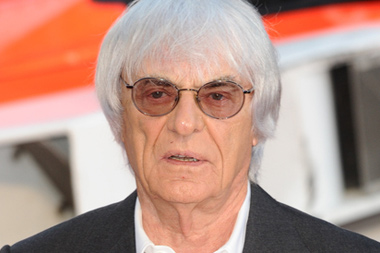"You'll miss me when I'm gone!": Is it always right to wrest power from defiant leaders?

When leaders stick their necks out no matter what, is it a sign of bone-headed stubbornness, or visionary vigour?
Jermaine Haughton
In the latest, mind-blowing twist to the FIFA corruption crisis, Sepp Blatter was today heard to say “You can't just ask people to behave ethically just like that.” It’s a glittering addition to a long line of Blatter misfires, and proves that, whatever qualities the FIFA chief can be said to lack, brass neck and defiance are not among them.
Which makes Insights think: isn’t defiance in management and leadership something of a double-edged sword? On one hand, it can perpetuate buffoonery like sparks to dry tinder. On the other, it can actually be a sign of independent thought and “Wait – I’ve got a plan” chutzpah that can help leaders grit their teeth through the choppiest waves of criticism, and win through.
Here are three examples from each side of the seesaw…
The “outstaying their welcome / good riddance” club
1. Bernie Ecclestone, Formula One Group
Small in stature, but mammoth in influence, Ecclestone remains the dominant figure in the world’s most glamorous game. Credited with transforming a sport adored by a small group of enthusiasts into a £5bn industry, Ecclestone’s achievements have often been overshadowed by his rebellious and controversial comments, which have led to frequent calls for his resignation. In 2009, he was forced to apologise for strong views he expressed on dictators, saying that Hitler was a "man who could get things done." In a similar vein, he drew further criticism just last year by professing support for Russian premier Vladimir Putin – stating he “completely agrees” with anti-gay propaganda bills passed in the country which banned the promotion of non-traditional marriage. Ecclestone also allegedly paid part of a $44 million bribe to a German banker to steer the sale of F1 to its current owner CVC (he denies the charges and claims he was being blackmailed).
2. Paul Dacre, Daily Mail
In recent years, the Daily Mail has weathered a host of calls for the resignation of its pugnacious editor-in-chief. Last year, it looked as though Dacre may be forced to fall on his sword when a number of high-profile names rallied against the newspaper’s scathing attack on former Labour leader Ed Miliband’s father. Describing Raplh Miliband, who died in 1994, as “the man who hated Britain,” the paper was roundly barraged, with even Lord Sugar saying that Dacre had “gone too far this time.” Former cabinet minister Lord Heseltine added that the Mail was “carrying politics to an extent that is just demeaning, frankly.” More recently, the paper was forced to pay damages and apologise to Harry Potter author JK Rowling over a 2013 article about her time as a single mother, which incorrectly suggested that the author had cooked up a “sob story” about her pre-fame years. Rowling said the "misleading" and "unfair" article had injured her reputation and caused her great distress. But despite this all, Dacre remains at the Mail’s helm.
3. Steve Ballmer, Microsoft
When Ballmer handed over the software giant’s reins to new chief executive Sadya Nadella in February 2014, the move seemed emotional, but timely. However, recent reports have suggested that Ballmer had in fact long outstayed his welcome, and didn’t necessarily go of his own volition. Industry experts such as Patrick Moorhead, principal analyst with Moor Insights & Strategy, suggest the corporation’s board pushed Ballmer out. Despite tripling the revenue during his tenure as chief executive, Ballmer’s leadership saw Microsoft fail to compete with Apple and Samsung, as well as lag behind on the popularity of mobile and portable devices, as well as operating systems and apps. Furthermore, the current owner of basketball team, the Los Angeles Clippers was accused by former senior vice president of the company Joachim Kempim of by forcing out any colleagues who challenge his authority, ultimately damaging the company’s unity. In his book, Resolve and Fortitude: Microsoft's "Secret Power Broker" Breaks his Silence, Kempin also accused Ballmer of intentionally ousting executives who he saw as threats. Among them is former Windows chief Steven Sinofsky.
The “Give ‘em a chance, they’ve got a vision” gang
1. Charles Dunstone, TalkTalk
The Carphone Warehouse chief experienced a disastrous launch of his TalkTalk business in 2003, compounded by widespread criticism of its customer service systems, obscuring the fact that it offered relatively low-priced telephone line packages. Indeed, poor customer service continues to be associated with the firm, with TalkTalk rated as operating one of the most dreaded call centres in the UK, based on helpfulness, waiting times and staff knowledge. Despite that, Dunstone’s shrewd appointment of Dido Harding as chief executive has led to the no-frills company diversifying its telephone and broadband packages, and almost doubling its annual pre-tax profits from £57m to £122m since 2010, as well as lifting the company’s market value from £1.2bn to around £2.7bn during the same period.
2. Marc Bolland, Marks and Spencer
As the old adage goes, “following a legend is the hardest job”. M&S chief Bolland has shown immense determination to push through his costly turnaround plans in the face of pressure from investors and onlookers, having taken over the role from Sir Stuart Rose in 2009. The Dutchman has invested more than £2bn in overhauls of the Marks and Spencer warehouse network, IT infrastructure, website and clothing range as part of a recovery plan to drive up the firm’s lacklustre financial figures. His fiercely single-minded approach seems to be bearing fruit, as the high-street giant recently recorded its first rise in annual profit for four years. However, while the company’s underlying pre-tax profit rose by 6.1%, like-for-like sales of general merchandise, including clothing, slumped by 3.1% for the year April 2014 to 2015. It’s still all to play for.
3. Lee Kun-hee, Samsung
Kun-hee’s defiantly individualistic leadership steered Samsung through a testing period that could have triggered its demise. By changing the company’s strategy and culture – as well as that of other major businesses in Korea and elsewhere – the firm focused on developing high quality technological products from 1995 onwards, as opposed to the cheap, mass-produced and low-quality products the country had been renowned for since the 1960s. However, that strategy wasn’t without its major drawbacks, with workers and Samsung’s own brass publicly expressing concerns about the direction the company was taking. Opting for a more international attitude to entrepreneurship, Kun-hee imported foreign skilled labour while sending local workers abroad to learn the most up-to-date technological chops, turning the former Korean budget name into a global tour de force.
Image of Bernie Ecclestone courtesy of Featureflash / Shutterstock.

Press & Media Enquiries
For more information or to request interviews, contact CMI's Press Team on 020 7421 2705 or email press.office@managers.org.uk


